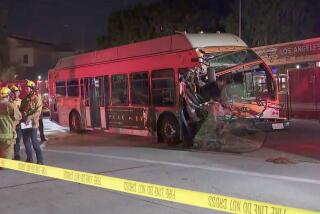Hidden wounds may hurt the most
In the 10 days since one of the worst commuter rail accidents in California history, the region’s trauma surgeons have reknit shattered limbs, repaired battered organs and returned dozens of patients to homes and families, where many will now face weeks or months of painful recuperation.
Twenty patients remain in the region’s hospitals as a result of the Sept. 12 head-on collision between a Metrolink commuter train and a Union Pacific freight train in Chatsworth. Four were still in critical condition Sunday.
The most obvious injuries were the open fractures, where splintered bones in arms and legs had punched through skin, spilling tissue and blood. But the biggest threat to those who survived the initial impact was the hidden mayhem inflicted on lungs, hearts, brains, livers and other internal organs when the train came to a dead stop, slamming bodies into seat backs, tables, the steel sides of the train cars and one another.
“It would be like standing against a wall and having a car hit you at 40 mph,” said Dr. Henry Gill Cryer, trauma director for the Ronald Reagan UCLA Medical Center, where several of the badly injured were treated.
In medical parlance, “trauma” has a precise definition: serious damage to the body from something external, like a gunshot wound or a car crash.
Other health crises, including heart attacks, pneumonia, appendicitis and injuries that are not life-threatening are treated in hospital emergency rooms. But for a hospital to be designated a trauma center, it must have, in addition to an emergency room, a team and equipment dedicated to treating severe injuries.
The new UCLA hospital, which was built to meet more stringent earthquake standards and opened in June, has the newest and most modern trauma center in Los Angeles County, at least until the replacement County-USC Medical Center opens in the fall. It has two rooftop heliports for receiving patients by helicopter and two resuscitation suites -- big, well-equipped rooms for treating the most seriously injured patients. X-ray machines, CT scanners and other imaging devices are in those rooms, rather than down the hall, to save crucial minutes in diagnosing internal injuries.
Of the 220 people on board the trains, 135 were injured, 86 of them seriously enough to be taken to hospitals, according to county officials. About 40 were in critical condition.
When eight of the critically injured arrived by helicopter at UCLA, Cryer’s team was waiting.
Speaking generally to protect the privacy of patients, Cryer described the types of injuries he and his team treated that night.
Besides the obvious broken arms and legs, some patients had fractures of the pelvis, spine and ribs. Those bones are especially strong, Cryer said, and a blow that is forceful enough to break them usually injures nearby organs and blood vessels as well.
One person’s punctured intestine popped open. Solid organs such as the liver and pancreas were fractured and bled profusely.
Loss of blood can lead to shock, a life-threatening emergency in which not enough oxygen is circulating to cells throughout the body. The only way to save the patient is to stop the bleeding. Three of the UCLA patients needed immediate surgery to accomplish that.
Some of the surgeries were relatively simple. Surgeons removed the damaged area of intestine, for example, and sewed the healthy ends together.
Other operations had to be done in stages. Surgeons cleaned open fractures to prevent infection and put the bones back into alignment with pins and rods, then waited a few days for the inflammation to abate before closing the wound.
One of the worst injuries was a fracture in the head of the pancreas, the area of the organ that shares a blood supply with the duodenum, the first part of the small intestine. Removing the broken portion required an all-day operation, and the patient’s condition was not stable enough for the ordeal.
“We learned 15 or 20 years ago that these patients don’t make it if the operation is done while they’re in shock,” Cryer said. “You get everything fixed, but the patient dies anyway.”
So Cryer’s team did damage control. Surgeons stopped the patient’s bleeding and cleaned the wound. A day and a half later, they removed the injured portion of the organ along with a damaged spleen and closed the abdomen.
Many organs have reserve capacity, allowing most people to survive even if a large part of an organ is removed, Cryer said.
After such surgery, it’s a matter of supporting the patients in the intensive-care unit until their bodies begin to heal. For the most badly injured, that means ventilators and intravenous feedings so the energy that would go into breathing and eating can be used for healing.
Depending on the severity of the injury, Cryer said, this stage can last from a few days to months.
During that time, the patients are susceptible to pneumonia, infection and arrhythmia, or irregular heartbeats.
“Any patient injured this badly is going to have complications,” Cryer said. “I tell the families this. It’s one step forward and two steps back.”
When patients can breathe and eat on their own, physical therapy begins. Then doctors decide which patients can continue therapy at home and which need to go to a rehabilitation hospital.
“After injuries like this, it’s months until they’re back to their normal selves,” Cryer said.
Like fractured legs, fractured lives may never be the same.
“We take someone who was perfectly normal one minute and the next minute has a devastating injury,” he said. “Our job is to get them back as close as possible to normal.”
--
--
RELATED STORY
MASH: Trauma centers were born on the battlefield. Page B4
--
RELATED STORY
UCLA: A doctor recounts the nerve-racking arrival and treatment of train crash victims. Health, F1
More to Read
Sign up for Essential California
The most important California stories and recommendations in your inbox every morning.
You may occasionally receive promotional content from the Los Angeles Times.










